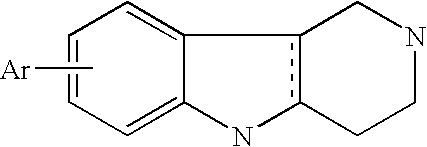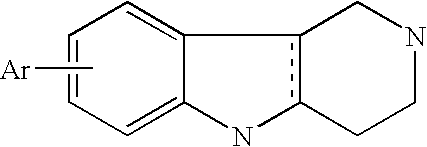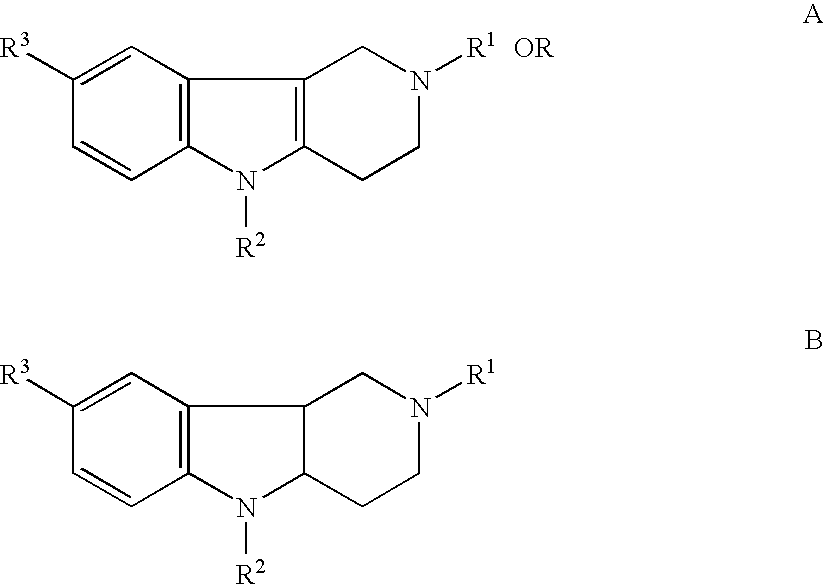Methods and compositions for treating schizophrenia
- Summary
- Abstract
- Description
- Claims
- Application Information
AI Technical Summary
Benefits of technology
Problems solved by technology
Method used
Image
Examples
example 1
Method of Evaluating the NMDA-Induced Current Blocking Properties of the Compounds
[0083] The drug “dimebon,” 2,8-dimethyl-5-[2-(6-methylpyridyl-3)ethyl]-2,3,4,5-tetrahydro-1H-pyrido[4,3-b]indole dihydrochloride of the Formula:
was taken as a representative of the compounds described herein.
[0084] Experiments were carried out by the patch clamp method on freshly isolated neurons of a rat brain cortex or on cultured rat hippocampus neurons. Neurons for cultivation were obtained from the hippocampus of neonatal rats (1-2 days) by the method of trypsinization followed by pipetting. Cells suspended in culture medium were placed in 3 mL quantities into the wells of a 6-well planchette (Nunc) or into Petri dishes, in which glasses coated with poly-L-lysine had first been placed. The cell concentration as a rule was 2.5×10−6−5×10−6 cell / mL. The culture medium consisted of Eagle's minimum medium and a DME / F12 medium (1:1) supplemented with 10% calf serum, glutamine (2 mM), gentamycin (50...
example 2
Use of an In Vivo Model to Determine the Ability to Compounds of the Invention to Treat Prevent and / or Delay the Onset and / or the Development of Schizophrenia
[0090] In vivo models of schizophrenia can be used to determine the ability of any of the hydrogenated pyrido[4,3-b]indoles described herein (e.g., dimebon) to treat and / or prevent and / or delay the onset and / or the development of schizophrenia.
[0091] One exemplary model for testing the activity of one or more hydrogenated pyrido[4,3-b]indoles described herein to treat and / or prevent and / or delay the onset and / or development of schizophrenia employs phencyclidene, which is chronically administered to the animal (e.g., non-primate (rat) or primate (monkey)), resulting in dysfunctions similar to those seen in schizophrenic humans. See Jentsch et al., 1997, Science 277:953-955 and Piercey et al., 1988, Life Sci. 43(4):375-385). Standard experimental protocols may be employed in this or in other animal models.
example 3
Use of Human Clinical Trials to Determine the Ability of Compounds of the Invention to Treat, Prevent and / or Delay the Onset and / or the Development of Schizophrenia
[0092] If desired, any of the hydrogenated pyrido[4,3-b]indoles described herein (e.g., dimebon) can also be tested in humans to determine the ability of the compound to treat, prevent and / or delay the onset and / or the development of schizophrenia. Standard methods can be used for these clinical trials.
[0093] In one exemplary method, subjects with schizophrenia are enrolled in a tolerability, pharmacokinetics and pharmacodynamics phase I study of a hydrogenated pyrido[4,3-b]indole using standard protocols. Then a phase II, double-blind randomized controlled trial is performed to determine the efficacy of the hydrogenated pyrido[4,3-b]indole.
PUM
| Property | Measurement | Unit |
|---|---|---|
| Fraction | aaaaa | aaaaa |
| Fraction | aaaaa | aaaaa |
| Fraction | aaaaa | aaaaa |
Abstract
Description
Claims
Application Information
 Login to View More
Login to View More - R&D
- Intellectual Property
- Life Sciences
- Materials
- Tech Scout
- Unparalleled Data Quality
- Higher Quality Content
- 60% Fewer Hallucinations
Browse by: Latest US Patents, China's latest patents, Technical Efficacy Thesaurus, Application Domain, Technology Topic, Popular Technical Reports.
© 2025 PatSnap. All rights reserved.Legal|Privacy policy|Modern Slavery Act Transparency Statement|Sitemap|About US| Contact US: help@patsnap.com



